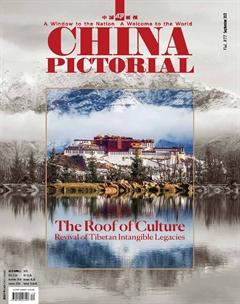Sticky Palace Heritage Special Exhibition of Palace Museum Stamps
by Nancy Gong
Although postage stamps are only a square inch in size, they can capture the history, science and technology, economics, culture, customs, and natural landscapes of a country. They can serve as a calling card of a nation. “The Palace Heritage in Stamps—Special Exhibition of Stamps on the Theme of the Palace Museum” opened in the Zhaigong (Hall of Abstinence) Gallery of the Palace Museum on May 17 for a four-month run ending on September 19 this year.
“History and modern times displayed on stamps in concert with cultural relics”is the aim of this exhibition. Interactive exhibits powered by new technologies enable visitors to experience “vivid cultural relics and stamps.” The event marks the first time that the cultural relics depicted on stamps issued by the Peoples Republic of China have been displayed alongside the stamps. A total of 1,732 stamps in 56 sets went on display including 52 sets of 1,590 stamps about the Forbidden City, 54 precious exhibits such as stamp manuscripts, and 25 pieces of cultural relics housed by the Palace Museum in various categories such as paintings, calligraphy, jade, enamelware, bronze ware, porcelain, and furniture.
The exhibition is divided into four sections: “Magnificent Landscapes,”“Great Architecture,” “Stamps and Relics: A Comparison,” and “Post Across a Thousand Miles.” The first section features stamps depicting Chinas most typically magnificent mountains and rivers as well as similarly themed relics from the Palace Museum such as A Panorama of Rivers and Mountains.
The Palace Museum was created from the Forbidden City, the imperial palace of the Ming (1368-1644) and Qing (1644-1911) dynasties. It is considered the largest existing wooden palace complex in the world. The museum houses more than 1.86 million exquisite cultural relics representative of the diligence and wisdom of the Chinese nation. Those relics served as a key source of inspiration for Chinas stamp designers. To fully capture the charm of the architecture of the Forbidden City and cultural relics housed in the Palace Museum, this exhibition displays not only images of Forbidden City architecture and cultural relics on stamps, but also original design sketches and manuscripts of engravings so that visitors can compare the cultural relics with the stamps and reflect on the evolution of such heritage. The multiple layers create a rich audience experience.
In 1990, China began to jointly issue stamps with other countries to showcase the cultures of both. The exhibition also includes Forbidden City stamps issued jointly by China and foreign countries to evidence the role of the Palace Museum in the international cultural exchange and the inclusiveness of Chinese civilization.

